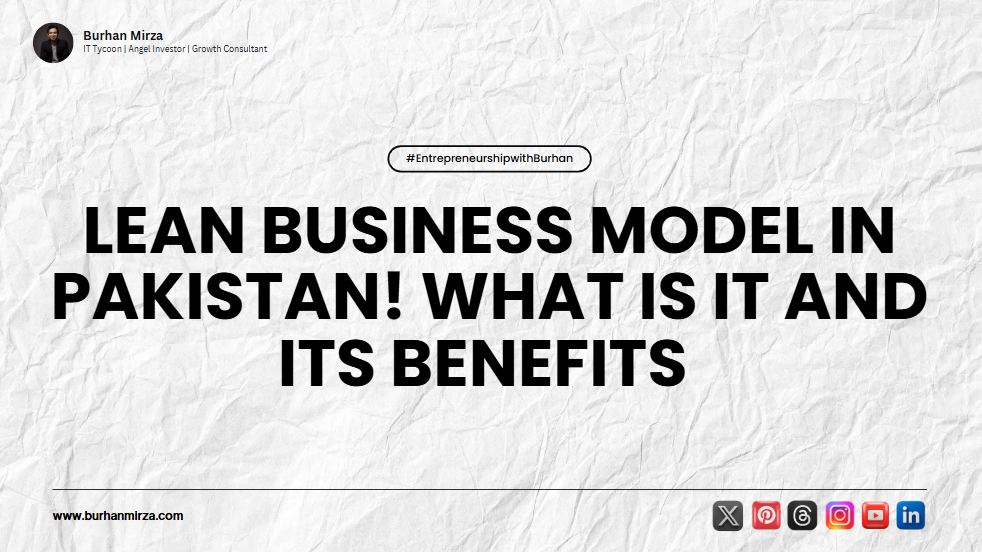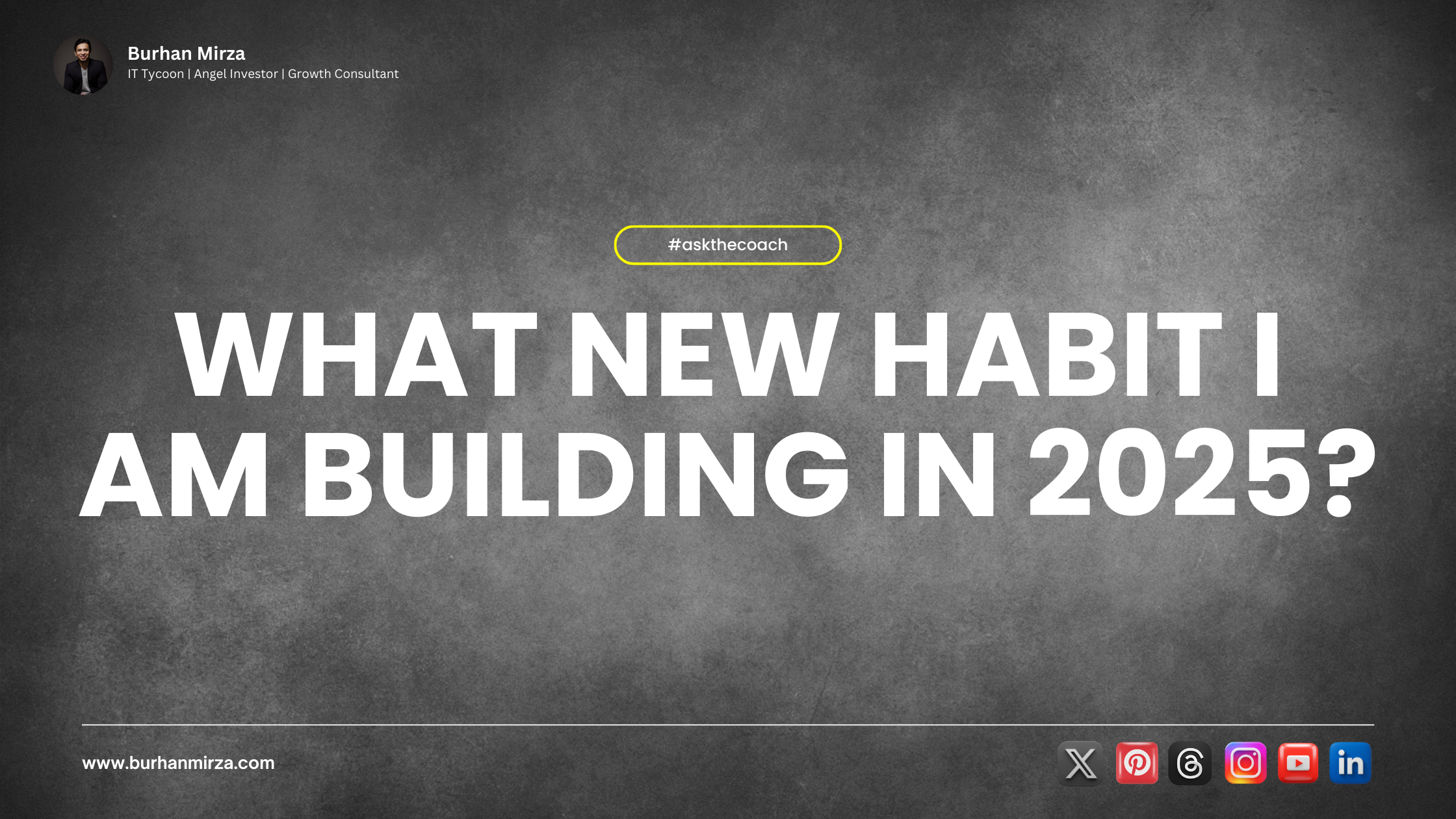 Blogs
Blogs
How to Build a Billion-Dollar Company in 365 Days
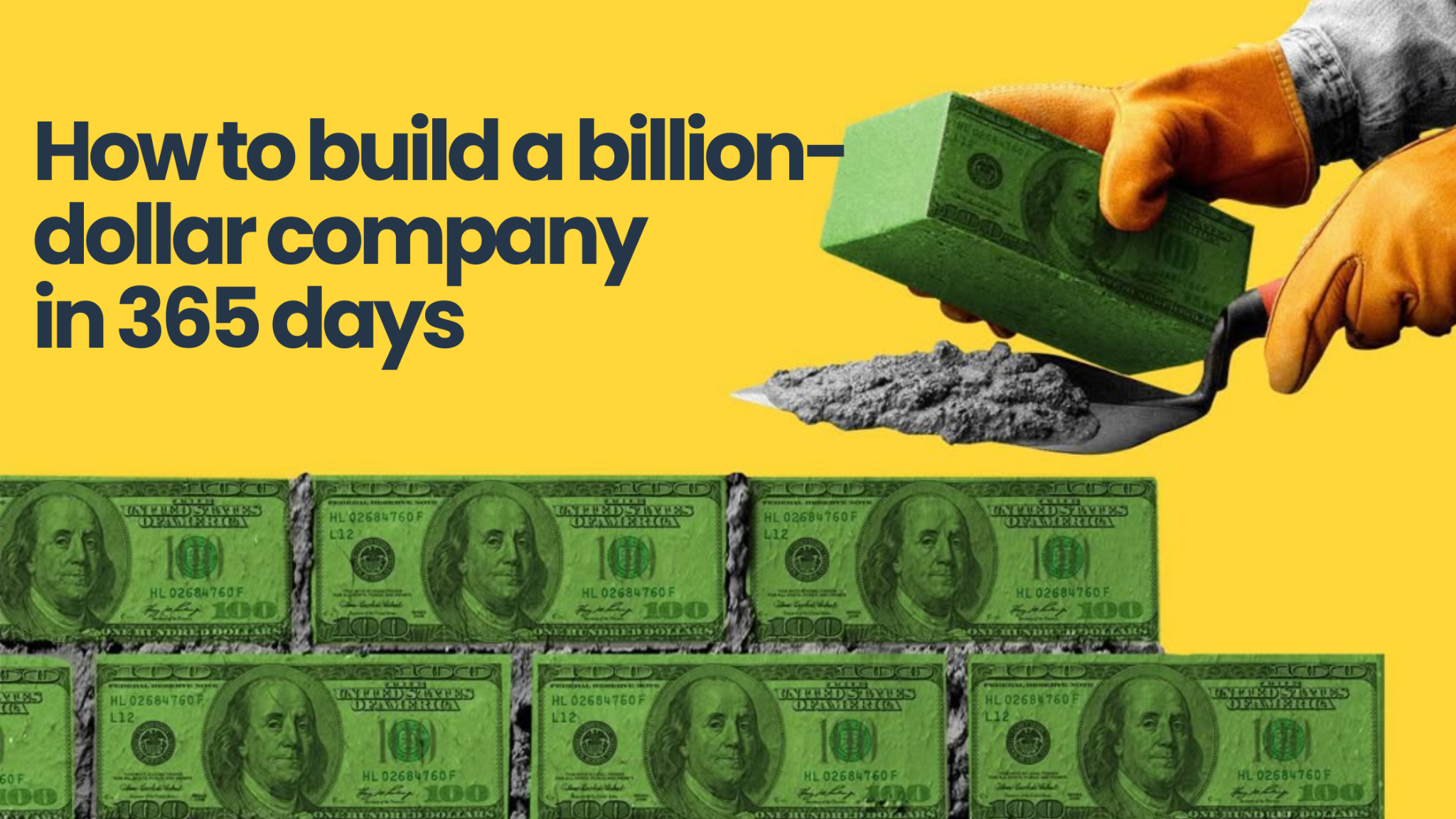
Key points:
- You can’t build a billion-dollar company in one year, but you can build the foundation for one through clarity, consistency, and strategic action.
- Success starts with vision before valuation; defining a purpose that scales globally and attracts both investors and talent.
- A strong brand narrative built on authenticity and emotion drives capital, loyalty, and long-term engagement.
- The 365-day plan focuses on four phases: foundation, traction, acceleration, and scale; each with measurable KPIs tied to growth.
- Achieving product-market fit fast requires constant validation, agility, and data-backed pivots without losing sight of the core mission.
- The billion-dollar mindset goes beyond numbers: it’s a mix of speed, humility, vision, and adaptability that defines enduring leaders.
Let’s make one thing clear, the title is written purely for clickbait purposes. You can’t build a billion-dollar company in a year no matter what the internet gurus say. There’s no secret formula, no magic shortcut, and no overnight success story that holds up under real scrutiny.
But here’s what you can do. You can lay the foundation for a billion-dollar company in 365 days, you can set the systems, culture, and direction that position your business for exponential growth. You can make decisions, build teams, and adopt habits that separate dreamers from doers.
This isn’t about chasing vanity valuations or trying to sprint your way to success. It’s about designing the blueprint for a company that can grow, scale, and sustain itself long after that first year. Because while a billion dollars might take time, the mindset that creates it can start today.
Why the “billion-dollar in a year” idea is not a fantasy but a framework
Now, let’s be real; every founder faces two major problems in that first year. The first is trying to do everything. You start with energy and ambition, but soon find yourself designing the product, managing clients, leading marketing, handling HR, and even making coffee. The result? Burnout and chaos. The solution isn’t working harder; it’s learning to delegate early. Build a team that complements your weaknesses. Empower them with trust and ownership. The sooner you stop being the only engine, the faster your company moves.
The second problem is chasing speed instead of strategy. Founders often confuse activity with progress, thinking more meetings, hires, and posts equal growth. In reality, speed without direction just amplifies mistakes. The fix? Slow down to plan. Define your core metrics, test your assumptions, and scale only what works. Controlled acceleration beats blind speed every time.
That’s how real billion-dollar companies are built; by thinking long-term, executing smart, and leading with purpose from day one.
Defining a mission that can scale
Here’s the truth most founders learn the hard way: money follows meaning. Vision always comes before valuation. You can raise funds, hire teams, and build products but if you don’t have a clear reason why your company exists, it won’t last. A strong vision acts like a compass; it guides every decision, keeps your team aligned, and attracts people who believe in more than just a paycheck.
Look at Elon Musk; Tesla and SpaceX weren’t born out of a desire to make quick profits. They started with a vision to revolutionize transportation on Earth and beyond. Or take Brian Chesky from Airbnb, who turned an air mattress in a small apartment into a global hospitality movement by reimagining how people connect through travel. Even Sara Blakely, founder of Spanx, didn’t chase valuation; she chased a problem millions of women faced and built a billion-dollar empire by solving it differently. Your mission needs to be big enough to scale. Think beyond local pain points and start identifying global problems that actually matter. The most successful founders don’t just fix what’s broken in their neighborhood; they build solutions that could work anywhere in the world. That’s what investors, partners, and customers connect with: a purpose that transcends borders.
And let’s talk about your brand narrative, because in today’s world, it’s just as powerful as your business model. The way you tell your story determines the kind of capital and talent you attract. People don’t rally behind spreadsheets; they rally behind stories of impact, resilience, and possibility. So, define your “why,” write it authentically, and make sure every touchpoint; from your website to your culture; reflects that mission. Because when vision drives the journey, valuation inevitably follows.
Building a brand that attracts capital and talent
Building a brand that attracts both investors and top talent isn’t about fancy logos or pitch-deck buzzwords. It’s about clarity, emotion, and consistency, the same formula used by some of the most successful companies in the world. Every great brand story follows a simple structure: the problem, the mission, and the movement. First, you define a real problem that people care about. Then, you show your mission, how your company is solving it in a way no one else can. Finally, you turn that mission into a movement people want to be part of.
For example, since the late 2000s, people were hugely depended on Video stores and rentals. Blockbuster was a HUGE deal back then. Your entire entertainment was characterized by timed TV shows, expensive tickets, and DVD rentals. You had to move out of the comfort of your home to go to the local blockbuster and find the movie you’re looking for. It was expensive and you had to horde ENTIRE collection of DVDs’ that could scratch if you weren’t careful enough. So, the main problem was limited access to entertainment controlled by traditional cable networks.
Netflix saw this problem and their mission? Give people the freedom to watch what they want, when they want. The movement? A global shift in how entertainment is consumed. That story didn’t just attract massive investment; it attracted creators, engineers, and storytellers who believed they were changing the way the world experiences entertainment.
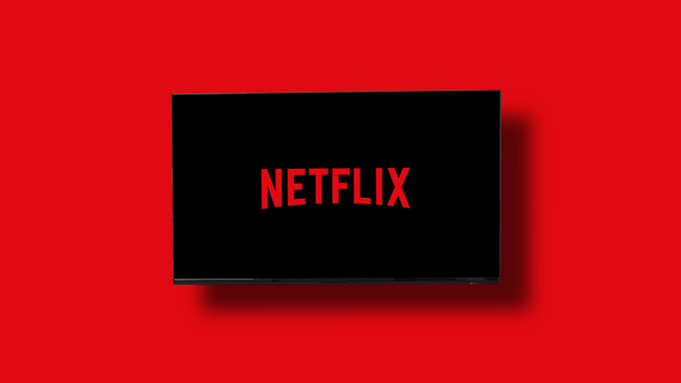
Or look at Nike. Their formula was empowerment. They didn’t just sell shoes; they sold inspiration. By turning athletes’ stories into symbols of perseverance and possibility, Nike created a narrative that resonated across cultures and generations. Investors saw the brand’s emotional pull, and top talent joined because they wanted to build something that inspired millions to “Just Do It.”

The best part? You don’t need to be a billion-dollar brand to do it. Startups can apply the same approach: lead with purpose, speak with authenticity, and make people feel something real. Investors fund belief as much as they fund numbers, and great talent joins missions, not just companies.
If your story can make someone say, “I want to be part of that,” you’ve already won half the battle.
The Power of the 365-Day Plan
The power of a 365-day plan lies in structure and intent. Building a company that lasts starts with having a clear roadmap for the first year. You can’t expect to achieve everything at once, but you can build momentum by breaking the journey into four key phases: foundation, traction, acceleration, and scale.
Phase 1: Foundation
This is where it all begins. The foundation phase is about defining your vision, building your core team, validating your idea, and setting up systems that can support future growth. It’s not the most glamorous part, but it’s the stage where you build the habits, processes, and culture that will carry your company forward.
Phase 2: Traction
Once your base is solid, you move into the traction phase. This is where you turn ideas into execution. It’s the period for launching your first products or services, testing your value proposition, and building early customer relationships. The goal here is to gather real data, refine your model, and start proving that your business works in the market.
Phase 3: Acceleration
The acceleration phase is where momentum builds. You identify what’s working and scale it strategically. This means doubling down on your strongest marketing channels, strengthening your operations, and expanding your team with precision. Growth at this stage is about focus and optimization, not chaos.
Phase 4: Scale
The scale phase is where you shift from growth to legacy building. By now, you have a validated model, a loyal customer base, and consistent revenue. This is the time to expand globally, diversify your offerings, and establish partnerships that reinforce long-term success.
Speed vs. Sustainability
Throughout these phases, the most important factor is balance. Set measurable KPIs that align with your long-term goals. Speed is crucial for momentum, but sustainability is what builds empires. Knowing when to pause, evaluate, and pivot separates companies that burn out from those that break through.
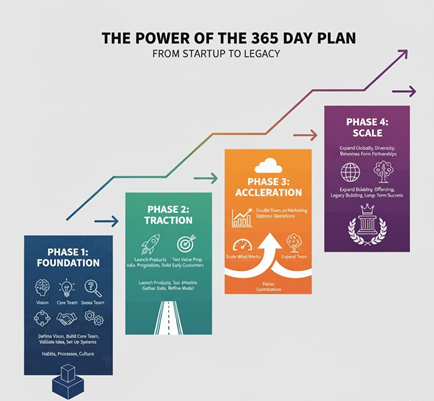
Product-Market Fit in Warp Speed
Finding product-market fit is every founder’s biggest challenge and the real turning point for any startup. It’s the moment your idea stops being just an idea and becomes something people are willing to pay for, recommend, and rely on. Most companies take years to reach that point, but in today’s fast-paced world, speed is everything. The goal isn’t to rush blindly; it’s to validate quickly and learn even faster.
Rapid Validation Frameworks
The fastest-growing companies don’t wait for perfection before launching. They start small, test early, and iterate often. Use rapid validation frameworks like MVPs (minimum viable products), customer interviews, and real-time feedback loops to see if your product solves a real problem. Think of how Dropbox launched with a simple explainer video before building the actual product, or how Slack tested its internal tool with a few companies before going public. These strategies help you validate demand before overinvesting in features or infrastructure.
Leveraging Data to Pivot Smarter
Every decision you make should be rooted in data, not guesswork. The key is to track the right metrics; engagement, retention, and conversion rates; rather than vanity numbers like downloads or impressions. Data gives you the clarity to pivot faster when something isn’t working. When Instagram realized its original app, Burbn, wasn’t connecting properly, the founders analyzed user behavior, saw people loved the photo-sharing feature, and rebuilt the product entirely around it. That pivot turned them into a billion-dollar company.
Listening to Markets Without Losing Vision
While adapting to the market is important, it’s equally crucial not to lose sight of your core vision. Feedback should inform your direction, not control it. The best founders filter noise from insight, staying flexible but grounded in purpose. Building with agility doesn’t mean abandoning your mission; it means finding smarter ways to fulfill it. When you learn to balance vision with validation, that’s when product-market fit becomes not just possible, but inevitable.
Building a High-Impact Team
Behind every great company is not just a great idea, but a group of people who know how to execute it. The truth is, you can have the best business model in the world, but without the right team, it’s just theory. Building a high-impact team isn’t about hiring fast or hiring friends; it’s about creating an ecosystem of people who can think, act, and grow at the speed your vision demands.
The best founders hire for capability, not comfort. It’s tempting to bring in people who agree with you or make things easy, but high-growth environments don’t thrive on comfort—they thrive on competence. Every early hire should raise the collective standard. You want people who are smarter than you in their domain, who challenge assumptions, and who bring a level of accountability that keeps everyone sharp. Think of how Jeff Bezos built Amazon by hiring people who could “disagree and commit,” or how Reed Hastings at Netflix built a culture around freedom and responsibility. Both leaders knew that innovation isn’t born from consensus; it’s born from constructive tension and trust.
A high-impact team also depends on your founding circle; your co-founders, advisors, and early believers. These are the people who shape the DNA of your company. Co-founders need to complement your weaknesses, not mirror your strengths. Advisors should bring experience, network access, and perspective that accelerate your learning curve. And those early believers; the first employees or investors; become cultural anchors who carry your mission forward when things get hard. The early stage is where culture is most fragile, so every addition matters.
Creating a Culture of Ownership and Urgency
Culture isn’t built through slogans or team lunches. It’s built through behavior. A high-impact culture is one where people think like owners, not employees. They don’t wait for permission; they see problems and fix them. Ownership creates accountability, and accountability builds momentum. To foster that, give your team autonomy with clear expectations. Let them make decisions, but make sure they understand the “why” behind them.
Urgency is another non-negotiable. Startups don’t compete on size; they compete on speed and execution. Create a sense of urgency that doesn’t burn people out but keeps them focused on progress. Celebrate wins, but move quickly to the next milestone. The goal is to make action a habit. When every person in the company feels like the company’s success is their personal responsibility, you no longer have a team; you have a movement.
Hire people who are obsessed with impact, give them the freedom to execute, and build a culture that rewards initiative over instruction. Because when the right people come together under a shared purpose, billion-dollar outcomes become a byproduct, not a goal.
Attracting and Structuring Smart Capital
Raising money is not about finding someone who will write a check; it’s about finding partners who understand your vision, believe in your market, and can help accelerate growth strategically. The smartest founders know that capital is not just currency, it’s chemistry. The wrong investor can drain your company’s energy and focus, while the right one can multiply your velocity tenfold. Smart capital is money that comes with mentorship, market access, and long-term alignment.
To attract this kind of capital, clarity and credibility are everything. Investors want to see not only what your business is today but where it can go tomorrow. This means having a strong narrative backed by real data: your traction metrics, your customer growth, your burn rate, and your competitive edge. The best founders pitch outcomes, not intentions. They demonstrate a deep understanding of market behavior and show investors that every dollar raised has a purpose tied to measurable results.
When it comes to structuring investment rounds, focus on maximizing long-term value, not short-term valuation. Overvaluation early on might look good on paper, but it can backfire in later rounds. Be strategic about dilution and consider investors who bring more than just money to the table. Some of the most successful companies like Canva and Stripe raised capital in stages that aligned perfectly with their operational milestones. Each round wasn’t just about fundraising; it was about fueling a new level of growth with the right kind of partners.

Financial Discipline and a Culture of Ownership
Once the capital is secured, the real challenge begins: managing it. Growth consumes cash faster than most founders anticipate, and in a hyper-growth environment, every decision impacts runway and scalability. The best strategy is to build a financial framework that balances aggression with discipline. This means monitoring cash flow weekly, forecasting worst-case scenarios, and maintaining liquidity buffers that allow your company to weather volatility. Profitability may not come immediately, but operational efficiency must always be a priority.
A strong financial strategy is not just built in spreadsheets; it’s embedded in culture. A company that thrives during rapid growth is one where every team member feels like an owner. When employees understand how their work impacts revenue, retention, and cost management, they begin to operate with urgency and accountability. Introduce transparency around financial goals, reward efficiency, and empower teams to make data-driven decisions.
The Art of Global Expansion
Going global is one of the biggest milestones for any company, but it is also one of the most misunderstood. True expansion is not about planting a flag in a new country or hiring a few people overseas; it is about building a sustainable presence that respects local markets while maintaining global consistency. Entering new markets requires more than ambition; it requires strategic precision.
Before expansion, founders need to ask the right questions: Is there real demand for our product? Does our model fit the local market dynamics? Are we ready to support global operations without diluting our brand or customer experience? Successful companies approach expansion in phases. They start small, validate quickly, and scale only when they understand the nuances of the new market. This prevents waste, protects brand equity, and ensures steady growth.
Understanding cultural, legal, and operational factors is critical. What works in one region may fail completely in another due to differences in consumer behavior, business regulations, or even simple communication styles. Localization is not just about translation; it is about adaptation. Companies like Starbucks and Netflix mastered this by tailoring their offerings to fit local tastes and cultures while staying true to their global identity
Partnerships play a major role in accelerating international growth. The right partnerships can open doors to local expertise, distribution networks, and trust that would otherwise take years to build. However, not all partnerships are worth pursuing. The best ones multiply impact rather than dilute it. Every collaboration should align with the company’s vision, enhance its capabilities, and extend its reach in meaningful ways. A partnership done right can turn a foreign market into a home ground.

Leadership Under Pressure
The true test of leadership does not come during periods of success but during moments of uncertainty and chaos. When markets shift, crises hit, or growth stalls, leaders are forced to make decisions that define the future of their companies. Maintaining clarity during these times is both an art and a discipline.
Great leaders rely on frameworks, not emotions, when navigating high-stakes environments. They focus on what they can control, prioritize facts over fear, and communicate with transparency. This builds confidence across teams and stakeholders even when the path ahead is unclear. Decision-making under pressure requires balance; between speed and thoughtfulness, optimism and realism, vision and execution.
The ability to lead through uncertainty is what separates good leaders from great ones. It is not about having all the answers but about creating direction when no one else can see it. During times of crisis, people do not just follow plans; they follow confidence. A steady, grounded leader gives teams the strength to keep moving forward even when things get hard.
Leadership in chaos also means protecting culture and morale. When teams feel lost, leaders must remind them of the mission and the “why” behind the work. That sense of shared purpose keeps everyone aligned, focused, and resilient. The best leaders understand that pressure is not an obstacle; it is a catalyst that shapes stronger people, smarter decisions, and ultimately, more enduring companies.
Lessons from the Journey
So, what does success in 365 days really look like? It is not about hitting a billion-dollar valuation or landing on the front page of a business magazine. Real success is about building momentum, establishing direction, and proving that your idea has the potential to go the distance. It is about turning chaos into structure, ambition into strategy, and effort into measurable progress. The first year is where foundations are laid, cultures are formed, and the DNA of your company is written.
Resilience, speed, and humility are what truly define that journey. Resilience keeps you standing when things inevitably go wrong. Speed allows you to seize opportunities before they disappear. And humility keeps you grounded enough to learn, pivot, and adapt without ego getting in the way. The combination of these three traits creates leaders who can build not just fast-growing companies, but lasting ones. The billion-dollar mindset goes far beyond financial targets. It is about thinking in systems, not moments. It means designing a business that can scale without losing its soul, building teams that grow with you, and creating value that outlives your quarterly reports. The truth is, most companies that eventually become billion-dollar giants don’t start out chasing billions; they start by chasing excellence, solving real problems, and learning relentlessly along the way.
If you can master that mindset in your first 365 days, you have already done something extraordinary. Because the goal was never just to build a billion-dollar company. It was to build a company worth believing in; a company that lasts.
 Muhammad Burhan Mirza
Muhammad Burhan Mirza My Story
My Story Events
Events Social Highlights
Social Highlights Blog
Blog Press Kit
Press Kit  Contributions
Contributions 
